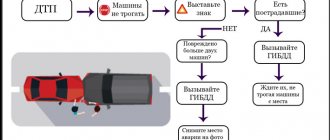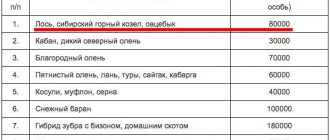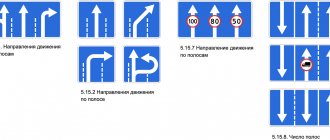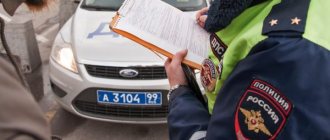How much are the new fines for downed animals? Table
The most important mistake of our time among car enthusiasts is that many consider the payment for a downed animal on the road to be a traffic police fine. This is not true - in fact, it is a payment to compensate for the damage caused.
Payment of a tax for a downed animal in Russia is separate from the traffic police fine as compensation for damage. A fine is assigned for a specific traffic violation. However, most often drivers are accused of failing to comply with the requirement of paragraph 10.1 of the Rules (incorrectly chosen speed, which did not allow monitoring the road situation), and for its violation there are simply no sanctions in the 2021 Code of Administrative Offenses of the Russian Federation.
So now let's take a look at the size of the new increased sanctions. They actually increased not so long ago, and their amounts became approximately 2 times higher than they were before.
These rates are established by the relevant Order of the Ministry of Natural Resources, Appendix No. 1 of the document.
Table of fines for hitting wild animals
| What kind of downed animal? | Amount of fine |
| Elk, musk ox or Siberian mountain goat | 80 000 |
| Wild boar, reindeer or musk deer | 30 000 |
| Noble deer | 70 000 |
| Sika deer, fallow deer, aurochs or saiga | 60 000 |
| Roe deer, mouflon or chamois | 40 000 |
| bighorn sheep | 100 000 |
| Hybrid of bison and bison or with livestock | 180 000 |
| Bear | 60 000 |
| Badger | 12 000 |
| Marmot, beaver, marten or harza | 6 000 |
| Sable, wolverine or otter | 15 000 |
| Lynx | 40 000 |
| Wolf, fox, jackal, raccoon or raccoon dog | 200 |
| Arctic fox, corsac fox, wild cat, mink, wild rabbit or hare | 1 000 |
| Ermine, solongoi, weasel, muskrat, ferret, weasel, squirrel or chipmunk | 500 |
| Mole, water vole, hamster, chipmunk or gopher | 100 |
| Capercaillie | 6 000 |
| Grouse, pheasant, snowcock or sajja | 2 000 |
| Goose or goose | 1 000 |
| Duck, hazel grouse, partridge, chukar, pigeon, coot or woodcock | 600 |
| Quail, rail, common crake, corncrake, moorhen, lapwing, tules, snapper, turnstone, ruff, grasshopper, snail, morodunka, godwit, curlew, snipe, great snipe, greenhorn, turtle dove | 200 |
We also have a special article on the downed elk situation.
Increased sanctions for animals from the Red Book
Please note, according to Appendix No. 2 of the Order of the Ministry of Nature of Russia, if an animal is listed in the Red Book of a constituent entity of the Russian Federation, then the fine for it will be increased by a factor of 5 or even 7.
The subject in this case means the region of Russia. For example, roe deer, sika deer and others may not be in the Red Book in the Moscow region, but be listed as endangered in the northern regions. Therefore, if you shoot down a wild animal in a specific region, an increased coefficient may be applied - that is, the fine will be 5 or 7 times higher:
- if you hit a male wild animal - coefficient 5,
- if it is a female – and, regardless of whether she is pregnant or not – 7.
In addition, in the table of fines above, animals can be shown simply in a generalized form. But the driver may run over a rare subspecies of animal.
Let's give an example. The driver was driving along the highway and hit a special red wolf in the Kaliningrad region. Since the animal is in the Red Book, the fine for it will be increased. If it was a male wolf - 1,000 rubles (instead of 200), and if it was a she-wolf - 1,400 rubles.
You will also be interested in:
- Hit a moose - all the details of an accident and what is the fine?
- Increasing the fine for driving without compulsory motor liability insurance to 5,000 rubles from January 1, 2021 - true or false?
- Bus lane according to traffic rules and fines for driving and stopping on it in questions and answers
If it's not your fault?
We found out above that for hitting an animal, you pay not a fine, but compensation for damage. But who is harmed in this case? Of course, to the state - if we are talking about a wild animal.
The fact is that all animals in nature legally belong to the state. Does this mean that the latter is obliged to monitor them so that they do not go out on the roads? Does this mean that if they didn’t follow up, then the state bears responsibility? Alas, no – and to both questions!
The judicial practice that has developed in 2021 directly speaks to this. The arguments of the courts in the event of an attempt to appeal a fine for running down an animal are almost always the same:
It is not possible to control or even track the movement of wild animals. Therefore, no government agency or institution can be held responsible for their movement, including access to the roads. At the same time, the driver, when driving along roads outside populated areas, is obliged to anticipate the possible exit of an animal from a forest belt or similar area of nature.
Here is an example of one of these court decisions.
Thus, almost always in the case of a collision with a wild animal, the driver of the vehicle is guilty of such an accident.
Expert opinion
Yuri Panchenko
Driving instructor, human rights activist, author of books. 10 years of experience.
The speed of information transfer from the eyes to the brain is small, designed for the speed of a running person. When information is received from the eyes, consciousness also uses memory to form a picture about the world around us. Obtaining the result of information processing takes a certain time, during which the car manages to travel some distance. And information from the periphery of vision becomes irrelevant.
As a result, consciousness ceases to perceive what is happening to the right and left of the road. At a speed of 120 km/h, the driver sees only his own lane in front of him. And, for example, the driver no longer sees a car that is closer than 40 m in the oncoming lane.
The appearance of an animal in the field of view of a driver who is moving at high speed is always unexpected.
Why do the "Cattle Driving" and "Wild Animals" signs show a cow and a moose? Their legs are thin, their center of gravity is high, and their mass is large. When a car hits their legs at high speed, the carcass of an animal weighing several hundred kilograms flies into the windshield with the most tragic consequences...
Ask a Question
Road accidents with wild animals - judicial practice
It is believed that the main cause of accidents involving wild animals is speeding by the driver (by the way, read about the fine for this here:). Let's look at a few examples to understand whether this is actually true and what punishment the driver ultimately suffered.
Case 1.
In the courtyard area, a car hit a dog, which at that time was walking on a leash, by its owner. The driver did not consider the incident worthy of his attention and drove away. The owner of the deceased dog filed a lawsuit, attaching video confirmation from an external surveillance camera of a nearby house.
As a result, the driver was charged with the following charges: leaving the scene of an accident, exceeding the speed limit in the courtyard, failure to provide assistance to a participant in an accident. Based on the information from the prosecution, the driver was deprived of his license for 1.5 years, paid an administrative fine for speeding, and will pay material and moral damages to the owner of the animal. (Read about the size of the fine for speeding here:)
Case 2.
Moving along the highway at a speed of 90 km/h, the car hit a deer. As a result, the deer died, and the car received damage in the form of a crumpled left fender and a broken side window. The driver of the vehicle decided not to involve the traffic police, put the deer carcass in the trunk and continued on. The driver of the car driving to the meeting recorded the incident on the dash cam and reported the accident to the traffic police.
During the trial, the culprit was not only deprived of his rights for a year and a half, but also received a fine in the total amount of 260,000 rubles. This amount included illegal hunting, compensation for a killed deer and a fine for leaving the scene of an accident.
Punishment for killing a wild animal
Accidents with wild animals threaten the motorist not only with fines, but also with serious damage to the car itself. For example, a collision with a moose rarely goes unnoticed by a car. To prevent accidents on the road, the driver must follow the signs and strictly adhere to the speed limit. If a wild animal was hit due to a violation of the speed limit, then you can receive additional penalties for this offense.
Let's take a closer look at what punishment a driver faces for hitting a wild animal. There is no way to avoid meeting with traffic police officers. The results of the collision will be on the “face” of the car. By the way, the insurance company compensates for damage caused to the car as a result of a collision with a wild animal. Although subsequently insurance will cost the driver more (additional risks will be included in the package).
The punishment for hitting a wild animal can be different and depends on the aggravating circumstances - compliance with traffic rules and speed limits, visibility on the road, etc.
The courts consider each case individually and make informed decisions. The main thing is not to aggravate the situation, and under no circumstances try to escape from the scene or hide a dead animal. If you want to take advantage of the situation and take the carcass for yourself, you can receive an additional fine for illegal hunting in the amount of up to 200,000 rubles.
Were there any changes in 2021?
No. Despite the fact that fines for downed wild animals are called new, they are relatively so. Because the latest changes in the corresponding table of compensation rates for animals came into force in February 2021, and not in 2021 at all.
But the truth is that these fines then doubled for almost all animals. For example, if previously you would have paid 15 thousand rubles for a downed wild boar, today you will be forced to pay 30 thousand. And the maximum established fine is various bison hybrids - 180,000 rubles.
Let's take a comparative look at the amendments to increase sanctions for accidents involving the most common living creatures on Russian roads.
Comparative table of changes in fines for downed animals
| Animal | Old fine | New fine |
| Elk | 40 000 | 80 000 |
| Wild boar, reindeer | 15 000 | 30 000 |
| Roe | 20 000 | 40 000 |
| Bear | 30 000 | 60 000 |
| Beaver, marten | 3 000 | 6 000 |
| Lynx | 20 000 | 40 000 |
| Wolf, fox | 100 | 200 |
| Arctic fox, mink, hare | 500 | 1 000 |
| Ferret, muskrat | 500 | 500 |
| Weasel | 200 | 500 |
| Chipmunk | 50 | 500 |
| Mole | 50 | 100 |
| Duck, partridge pigeon | 300 | 600 |
As you can see, most fines have doubled, with the exception of some animals (weasel, chipmunk).
What is the fine for an Amur tiger?
The paradox of the legislation is that the above table of fines for downed animals does not include one of the most endangered species living in Russia - the Amur tiger, as well as any other subspecies of tigers.
Meanwhile, in some old and recent news you can find information that the prosecutor’s office opened a case for allegedly shooting down a tiger and assessed the animal. But there are no legal grounds for such recovery of an animal that is in the Red Book, but the amount of damage for which is not established in regulations, in terms of determining the amount of compensation for damage. Although, since the damage was still caused, it is subject to compensation by law.
Is there a sanction for a pigeon, hedgehog, fox and other small animals?
There are also a number of animals that very often run out onto the road from forests and fields. However, not all of them are subject to sanctions.
For example, for the following animals the fee is fixed by the above Order of the Ministry of Natural Resources:
- fox – 200 rubles,
- pigeon – 600 rubles,
- gopher – 100 rubles,
- elk – 80,000 rubles,
- wild boar – 30,000 rubles,
- hare – 1,000 rubles.
Please note that the fine for an ordinary pigeon is 3 times higher than for a downed fox.
And the following animals “can be shot down for free”:
- an ordinary mouse (only for a water vole there will be a fine of 100 rubles),
- hedgehog,
- all types of snakes.
What is the penalty for a dog, cat or chicken?
But for pets, a fine is much less likely. The fact is that if wild animals are the property of the state, and the judicial practice of 2021 established that there is no obligation to monitor them, as well as to be responsible for them, then for domestic animals the responsibility is assigned to their owners.
Thus, if a driver hits a domestic dog, cat, cow, calf, bull, horse, or even a chicken, duck, or goose that has an owner, then the owner may be liable for compensation. But do not forget that Article 1079 of the Civil Code of the Russian Federation also applies here, prescribing driving a car as a source of increased danger and the obligation to compensate for harm, regardless of the presence of fault in an accident with an animal.
Although, according to the Civil Code, a pet is property.
A dog was hit by a car: consequences
If a dog is hit by a car, the consequences can be dire not only for the animal itself. Undoubtedly, the driver may face deprivation of the right to drive a car or imprisonment, but this, of course, is the case if there was an attempt to escape from the scene of the accident.
In all other cases, in case of proven guilt, the driver is obliged to pay for the treatment of the animal. Be extremely sensitive in these matters; it is better to resolve everything peacefully, because if the innocent party goes to court, you will also have to pay legal costs.
In any case, do not forget about human qualities. We are responsible for those we have tamed. If you hit an ownerless animal, try to help him and take him to the hospital. If the animal dies, at least remove it from the roadway so that it does not interfere with traffic.
Will insurance cover MTPL?
The good news for motorists who have been involved in a collision with a wild animal is that, other things being equal, the MTPL agreement covers damage caused by the vehicle to this animal.
Since the current liability limit in 2021 is 400 thousand rubles, all animals in the table above without exception are subject to full compensation.
Something else useful for you:
- What are the fines for driving without paying on a toll road? New law on non-payment of toll sections
- New traffic police fines and changes to traffic rules from March 1 and 20 - true or false?
- New fine for stopping and parking on the lawn - true or not?
What to do if a car hits a dog and kills it?
If the animal dies, the law requires action in accordance with the provisions of Article 2.5 of the Russian Federation Traffic Regulations. The driver is obliged to stop, turn on the hazard warning lights, put up an emergency stop sign, and then call the traffic police and clarify whether he needs to wait for the inspector to arrive or whether he needs to independently arrive at the nearest traffic police post to register the accident. The scene of the incident must be recorded using photos and videos. It is recommended to remove the dead animal from the road to the side of the road.
If the driver has compulsory motor insurance and the animal does not have an owner, you should not contact the insurer. The organization will refuse to provide compensation. When the dog is a pet, the driver is at fault for the accident, and the owner of the animal has claims, it is necessary to contact the insurance institution. This will shift the need to provide compensation onto the shoulders of the insurer.
If the dog owner is to blame for a traffic accident and the car is damaged, Art. 1064 of the Civil Code of the Russian Federation. The car owner has the right to seek compensation through the court. To do this, you will need to file a statement of claim. It is recommended that you first contact the owner of the animal and try to come to an agreement out of court.
Should there be a "Wild Animals" sign on the highway?
Yes. The obligation to install this sign is dictated by clause 5.2.29 of GOST R52289-2004. It is placed in front of the place where animals most often enter the road (in front of elk trails crossing the roadway, and so on).
But does this mean that you can challenge guilt in an animal hit by a car if the highway was unsigned? Unfortunately no. In almost all acts of judicial practice, you can see a situation where a driver tries to justify himself by the absence of a “Wild Animals” sign. And it's almost always useless.
The point here is that judges assure those responsible for such accidents that sign 1.27 is a warning sign. It is neither recommendatory nor binding. At the same time, it is also impossible to control the appearance of wild animals in places where they may appear rarely. Therefore, the driver is obligated to comply with the notorious clause 10.1 of the traffic rules, and if something happens, failure to comply with his requirements will be charged to the motorist in the event of a downed wild animal.
What to do if you hit a cat - accidents with animals on the recorder
Most often, cats get into accidents. They do not recognize traffic rules and other people's authority. At the same time, their speed of movement is on average 13.5 km/h, but can reach up to 50 km/h. Despite these facts, the driver must be vigilant and monitor the situation on the road, and, if necessary, react in time to avoid a sudden obstacle.
Most drivers treat a hit cat with disdain and simply drive by, but you need to know that such a minor situation can turn into serious problems. The registrar in this case works as a witness to the incident and can either help the driver or aggravate his guilt. If the driver was not at fault and the collision could not be avoided, then having a record on the recorder will help the driver avoid administrative punishment.
The cat's owner may seek compensation for damages caused, especially if the driver ran a red light. The law of the Russian Federation provides for the right of the animal owner to compensation for material and moral damage.










